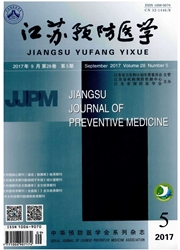

 中文摘要:
中文摘要:
目的:分析江苏省食盐加碘前后人群碘营养状况的变化情况,为食盐加碘防治碘缺乏病策略与措施调整提供依据。方法:采用1995年-2009年间江苏省开展的7次省级碘缺乏病病情监测调查结果进行比较。结果:8~10岁学龄儿童尿碘中位数从1995年的不足100μg/L(为85μ/L)上升至1999年的最高点(406.6μg/L),至2005年调整回落到243.5μg/L,2009年重新上升至325.3μg/L;盐碘含量均值随着国家食盐加碘浓度的调整而变化,近年来稳定在30mg/kg左右;各次调查尿碘中位数和盐碘均数相关系数r为0.863(P〈0.05);以20-50mg/kg计,合格碘盐食用率于2002年起始终保持在94%以上;触诊和B超法检测甲状腺肿大率分别由17.43%(1995年)、8.75%(1997年)下降至2009年的1.70%和1.00%。结论:江苏省食盐加碘后人群碘营养状况明显改善,建议保持运行监测-反馈-调整的碘缺乏病防治机制,补充完善碘缺乏病防治指标体系,增加特需人群碘营养监测。
 英文摘要:
英文摘要:
Objective: To provide suggestions for further iodine deficiency disorders (IDD) strategy and measurement by analysis changes on iodine status of people before and after salt iodization in Jiangsu Province. Methods: To compare with the seven survey dataset get by people's proportional sampling (PPS) method from the year 1995 to 2009 in Jiangsu Province. Resuits: Median of urine iodine of children aged 8 to 10 years varied from 85.0μg/L (less than 100μg/L) in 1995 to the highest 406.6μg/L in 1999, then went down to 243.5μg/L in 2005, and again rose to 325.3μg/L in 2009. Mean of household salt iodine changed correspondingly with the national iodized salt concentration adjustment, which stabled at about 30mg/kg around 2005 to 2009. Relation coefficient between median of urine iodine and mean of salt iodization (r) was 0. 863 (P〈0. 05). With the criteria between 20 to 50 mg/kg, household usage rates of adequately iodized salt have steadily been above 94% since 2002. Thyroid goiter rate measured by palpation and ultrasound dropped from 17. 4% in 1995 and 8. 8% in 1997 to 1.7 % and 1.0% in 2009, respectively. Conclusions: Iodine status of people in Jiangsu Province has been proved remarkably since salt iodization in 1995. We suggest we should hold on the effective system of surveillance--feedback--adjustment of IDD prevention and control and reinforce the indicators system by adding iodine status surveillance on the special--need people, such as pregnant or lactation women, new--marriage young ladies, infants, and so on.
 同期刊论文项目
同期刊论文项目
 同项目期刊论文
同项目期刊论文
 期刊信息
期刊信息
